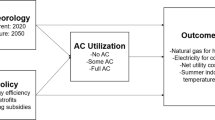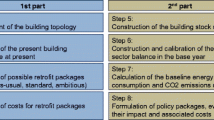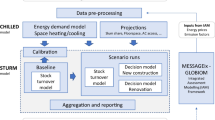Abstract
In Latin America, default assumptions and borrowed templates and methodologies are often used in energy modeling, resulting in models that might not represent their cultural context and leading to policies awkwardly fit to local practices. Policy-driving low-income housing studies in Mexico, for example, activated both heating and cooling in energy models even though less than 5% of the homes in the country have heating systems. This paper illustrates the importance of modeling local sociocultural habits and practices, and how this can affect design outcomes. Here, we modeled low-income housing representative of typical residences in two desert climates—Hermosillo, Mexico, and Copiapo, Chile—using EnergyPlus. Settings representing local practices in each region were tested against default values, including occupancy settings, regional construction systems, and importantly, HVAC settings related to partial conditioning. Their impacts were measured via variation in energy use, comfort conditions, and the payback period of design upgrades. Results demonstrated how certain assumptions can have a high “design significance”, a term we propose for inputs that completely change optimal design decisions, as well as the importance of considering thermal comfort in such decisions. Including partial conditioning, for example, resulted in at least double the payback period and discomfort degrees for design upgrades in 16 of 24 instances.
Similar content being viewed by others
References
Al-Mumin A, Khattab O, Sridhar G (2003). Occupants’ behavior and activity patterns influencing the energy consumption in the Kuwaiti residences. Energy and Buildings, 35: 549–559.
ASHRAE (2016). ASHRAE Standard 90.1-2016—Energy Standard for Buildings Except Low-Rise Residential Buildings. Atlanta, GA: American Society of Heating, Refrigerating and Air-Conditioning Engineers.
Bustamante W (2016). Estudio Sobre Rangos de Confort Térmicos y Riesgo de Sobrecalentamiento En El Contexto de La Aplicación de Nuevos Estándares de Desempeño Térmico En Viviendas Etapas 3 y 4. Informe 9. Ministerio de Vivienda y Urbanismo. (in Spanish)
Campos Arriaga L (2011). Propuestas de Optimización de la Eficiencia Energética en Viviendas de Interés Social. Mexico: GIZ. (in Spanish)
Cedeno Laurent JG, Samuelson HW, Chen Y (2017). The impact of window opening and other occupant behavior on simulated energy performance in residence halls. Building Simulation, 10: 963–976.
Centro Mario Molina (2014). Análisis de barreras para la instrumentación de tecnologías de baja intensidad de carbono y propuestas para su eliminación. Available at http://centromariomolina.org/wp-content/uploads/2014/12/Resumen-Barreras.pdf_(in Spanish)
Clevenger CM, Haymaker JR, Jalili M (2014). Demonstrating the impact of the occupant on building performance. Journal of Computing in Civil Engineering, 28: 99–102.
CFE (n.d.). Nuevo Esquema Tarifario (Diciembre 2017–2019). Comision Federal de Electricidad (CFE). Available at https://app.cfe.mx/Aplicaciones/CCFE/Tarifas/TarifasCRECasa/Casa.aspx. Accessed 5 Jan 2019. (in Spanish)
Comisión Nacional de Vivienda, Secretaría de Medio Ambiente y Recursos Naturales (2012). Supported NAMA for Sustainable Housing in Mexico—Mitigation Actions and Financing Packages. Available at http://www.conavi.gob.mx/documentos/publicaciones/4_Supported_NAMA_for_Sustainable_Housing_in_Mexico.pdf
Compañía General de Electricidad (2018). Tarifa de Suministro Eléctrico - 1 de diciembre de 2018. Available at http://www.cge.cl/wp-content/uploads/2018/12/CGE_Tarifas-de-Suministro_Diciembre-2018.pdf
CDT (2010). Informe Final Y Resumen Ejecutivo. Estudio de Usos Finales y Curva de Oferta de la Conservación de la Energía en el Sector Residencial. Corporación de Desarrollo Tecnológico (CDT). Available at http://dataset.cne.cl/Energia_Abierta/Estudios/Minerg/Usos%20finales%20y%20curva%20de%20oferta%20de%20conservaci%C3%B3n%20de%20la%20energ%C3%ADa%20en%20el%20sector%20de%20residencial%20de%20Chile.pdf. (in Spanish)
Davis L, Martínez S, Taboada B (2018). ¿Cuán efectiva es la eficiencia energética en vivienda?: Evidencia de un experimento de campo en México: Resumen ejecutivo. (in Spanish)
Desaloja Infonavit 8,000 viviendas en Sonora | Federación de Trabajadores del Estado de Sonora - CTM. (n.d.). Available at http://www.ctmsonora.org/?p=3106. Accessed 10 Jan 2019. (in Spanish)
DesignBuilder (2018). Available at https://www.designbuilder.co.uk.
EnergyPlus (2018). US Department of Energy. Available at https://energyplus.net.
Estrella Guillén E, Samuelson HW, Cedeño Laurent JG (2019). Comparing energy and comfort metrics for building benchmarking. Energy and Buildings, 205: 109539.
Evite encender el aire acondicionado, aún no hay subsidio: Unión de Usuarios (2018). Periódico Expreso. Available at https://www.expreso.com.mx/seccion/hermosillo/33567-evite-encenderel-aire-acondicionado-aun-no-hay-subsidio-union-de-usuarios.html.
Gaetani I, Hoes PJ, Hensen JLM (2018). Estimating the influence of occupant behavior on building heating and cooling energy in one simulation Run. Applied Energy, 223: 159–171.
Hong T, Yan D, D’Oca S, Chen CF (2017). Ten questions concerning occupant behavior in buildings: The big picture. Building and Environment, 114: 518–530.
Horta A, Wilhite H, Schmidt L, Bartiaux F (2014). Socio-technical and cultural approaches to energy consumption: an introduction. Nature and Culture, 9: 115–121.
INEGI (2015). Encuesta Intercensal 2015. Instituto Nacional de Estadística, Geografía e Información (INEGI).
INEGI (2016). Mujeres y Hombres en México 2016. Instituto Nacional de Estadística, Geografía e Información (INEGI). Available at http://cedoc.inmujeres.gob.mx/documentos_download/MHM_2016.pdf.
INEGI (2018). Encuesta Nacional sobre Consumo de Energéticos en Viviendas Particulares 2018. Presentación de Resultados. Instituto Nacional de Estadística, Geografía e Información (INEGI). Available at http://www.beta.inegi.org.mx/contenidos/programas/encevi/2018/doc/encevi2018_presentacion_resultados.pdf.
INE (2017). Censos de Población y Vivienda. Instituto Nacional de Estadística (INE). Available at http://historico.ine.cl/canales/chile_estadistico/censos/censo_poblacion_vivienda.php.
Long C, Mills BF, Schleich J (2018). Characteristics or culture? Determinants of household energy use behavior in Germany and the USA. Energy Efficiency, 11: 777–798.
Marincic I, Ochoa JM, Alpuche MG (2014). Passive house for a desert climate. WIT Transactions on the Built Environment, 142: 13–24.
McNeil M, Castellanos S, De Leon Barido DP, Sánchez Pérez PA (2018). Mexico Space Cooling Electricity Impacts and Mitigation Strategies.
MINVU (2007). Manual de Aplicación Reglamentación Térmica. Art 4. 1. 10 Ordenanza General de Urbanismo y Construcción. Ministerio de Vivienda y Urbanismo (MINVU). Santiago, Chile: Comisión Nacional de Energía. (in Spanish)
MINVU (2010). Política Urbano Habitacional de Calidad e Integración: Buenos Proyectos para Compartir. Ministerio de Vivienda y Urbanismo (MINVU). Santiago, Chile: Ministerio de Vivienda y Urbanismo. (in Spanish)
MINVU (2015). Tabla Referencial de Precios Unitarios PPPF 2015. Ministerio de Vivienda y Urbanismo (MINVU). (in Spanish)
Nahmens I, Joukar A, Cantrell R (2015). Impact of low-income occupant behavior on energy consumption in hot-humid climates. Journal of Architectural Engineering, 21(2): B4014006.
Ochoa JM, Marincic I, Alpuche MG, Duarte EA, Gonzalez I, et al. (2014). Cost benefit energy analysis of the building envelope systems with Ener-Habitat. Energy Procedia, 57: 1792–1797.
Organisation for Economic Co-operation and Development (2011). OECD Economic Surveys. Mexico.
Paone A, Bacher JP (2018). The impact of building occupant behavior on energy efficiency and methods to influence it: a review of the state of the art. Energies, 11: 953.
Passive House Institute. (2012). Technical Annex: Evaluation of social housing building types in Mexico. In Supported NAMA for Sustainable Housing in Mexico—Mitigation Actions and Financing Packages. Available at http://www.conavi.gob.mx/documentos/publicaciones/4_Supported_NAMA_for_Sustainable_Housing_in_Mexico.pdf.
Preciado-Pérez OA, Fotios S (2017). Comprehensive cost-benefit analysis of energy efficiency in social housing. Case study: Northwest Mexico. Energy and Buildings, 152: 279–289.
Rubio-Bellido C, Pérez-Fargallo A, Pulido-Arcas JA, Trebilcock M (2017). Application of adaptive comfort behaviors in Chilean social housing standards under the influence of climate change. Building Simulation, 10: 933–947.
SENER (2011). Norma Oficial Mexicana NOM-020-ENER-2011, Eficiencia energética en edificaciones - Envolvente de edificios para uso habitacional. Secretaría de Energía (SENER). (in Spanish)
Secretaría de Obras y Servicios (2017). Tabulador General de Precios Unitarios Octubre 2017. Available at https://www.obras.cdmx.gob.mx/servicios/servicio/tabulador-general-de-precios-unitarios. (in Spanish)
SHF (2018). EcoCasa - Casas eficientes para todos. Sociedad Hipotecaria Federal (SHF). Available at https://www.gob.mx/shf/documentos/ecocasa. (in Spanish)
Sovacool BK, Ryan SE, Stern PC, Janda K, Rochlin G, et al. (2015). Integrating social science in energy research. Energy Research & Social Science, 6: 95–99.
Sun K, Hong T (2017). A simulation approach to estimate energy savings potential of occupant behavior measures. Energy and Buildings, 136: 43–62.
Wasilowski H, Reinhart C (2009). Modelling an Existing Building in Designbuilder/Energyplus: Custom versus Default Inputs. In: Proceedings of the 11th International IBPSA Building Simulation Conference, Glasgow, UK.
Wilhite H, Nakagami H, Masuda T, Yamaga Y, Haneda H (1996). A cross-cultural analysis of household energy use behaviour in Japan and Norway. Energy Policy, 24: 795–803.
Wilk RR, Wilhite HL (1985). Why don’t people weatherize their homes? An ethnographic solution. Energy, 10: 621–629.
Wilson C, Dowlatabadi H (2007). Models of decision making and residential energy use. Annual Review of Environment and Resources, 32: 169–203.
Yan D, O’Brien W, Hong T, Feng X, Gunay HB, et al. (2015). Occupant behavior modeling for building performance simulation: Current state and future challenges. Energy and Buildings, 107: 264–278.
Zhang Y, Bai X, Mills FP, Pezzey JCV (2018). Rethinking the role of occupant behavior in building energy performance: A review. Energy and Buildings, 172: 279–294.
Acknowledgements
This study was partially funded by the Harvard Climate Change Solutions Fund. The majority of Esteban Estrella Guillén’s work was performed during a paid research position at Harvard GSD, his current affiliation is listed in the title page.
Author information
Authors and Affiliations
Corresponding author
Rights and permissions
About this article
Cite this article
Estrella Guillen, E., Samuelson, H.W. & Vohringer, C. The impact of cultural assumptions on simulated energy, comfort, and investment returns of design decisions in two desert climates. Build. Simul. 14, 931–944 (2021). https://doi.org/10.1007/s12273-020-0718-y
Received:
Revised:
Accepted:
Published:
Issue Date:
DOI: https://doi.org/10.1007/s12273-020-0718-y




